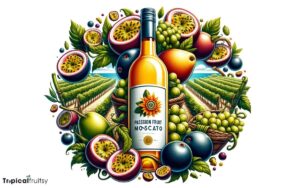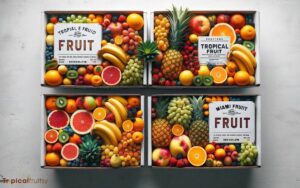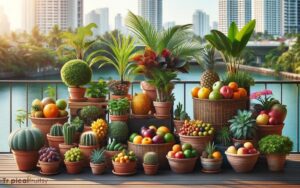How to Grow Tropical Fruit in Cold Climate? Top Methods
To successfully grow tropical fruit in a cold climate, gardeners must employ strategic methods that include selecting cold-tolerant fruit varieties, creating microclimates, and using greenhouses or other protective structures.
Proper soil preparation, irrigation, and the use of heating systems during colder periods are also necessary to sustain these warmth-loving plants.
Growing tropical fruit in colder climates involves several key strategies:
Growing a cold-hardy banana variety, such as ‘Musa Basjoo’, in a greenhouse with supplemental heat during the winter months.
Embrace the challenge of growing exotic tropical fruits in your backyard, even under the snow-laden skies of colder climates.
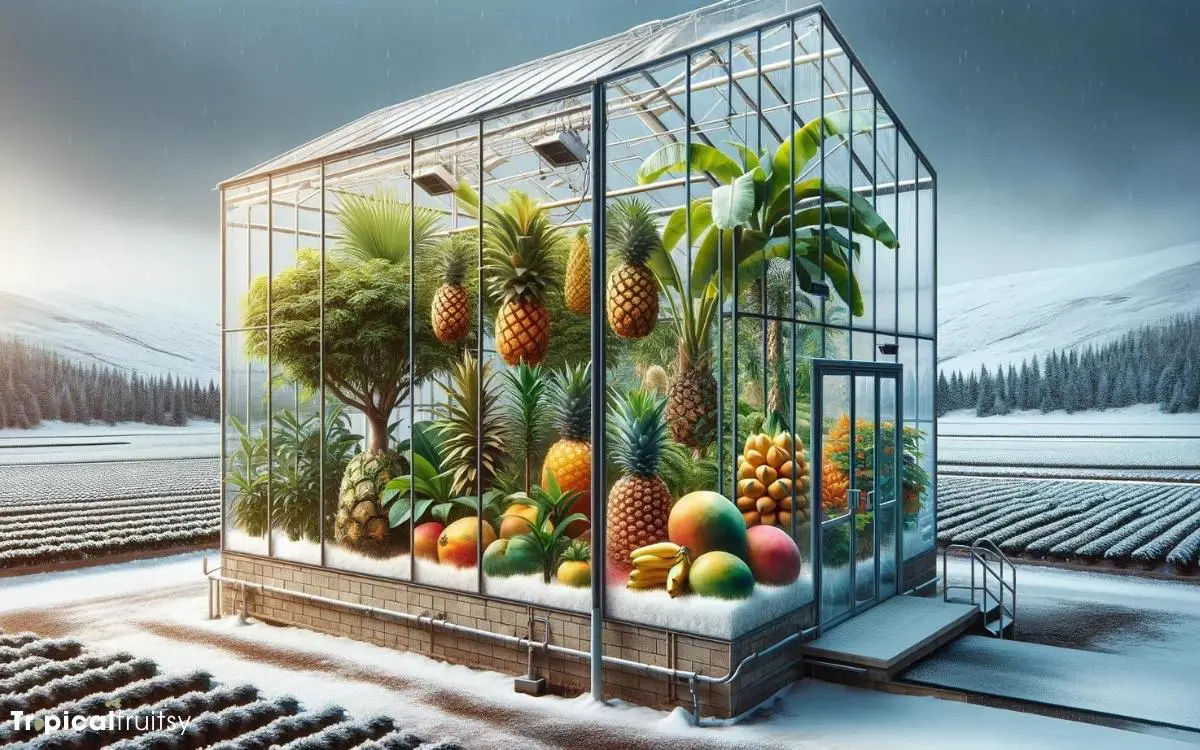
Key Takeaway
5 Cold-Hardy Tropical Fruits: Grow in Cold Climate
| Cold-Hardy Tropical Fruits | Description | Min. Temperature | Protective Measures |
|---|---|---|---|
| Persimmons | Sweet, orange fruit | -20°F (-29°C) | Mulch, shelter from cold winds |
| Feijoa (Pineapple Guava) | Guava-like fruit with mint hint | 15°F (-9°C) | Frost cloth, south-facing walls |
| Hardy Kiwi | Smooth-skinned miniature kiwis | -25°F (-32°C) | Overhead cover, windbreaks |
| Fig | Sweet fruit with soft skin | 15°F (-9°C) | Winter wrapping, sunny spots |
| Pomegranate | Tart, seeded fruit | 10°F (-12°C) | Wall support, heat sinks |
Assessing Climate Limitations
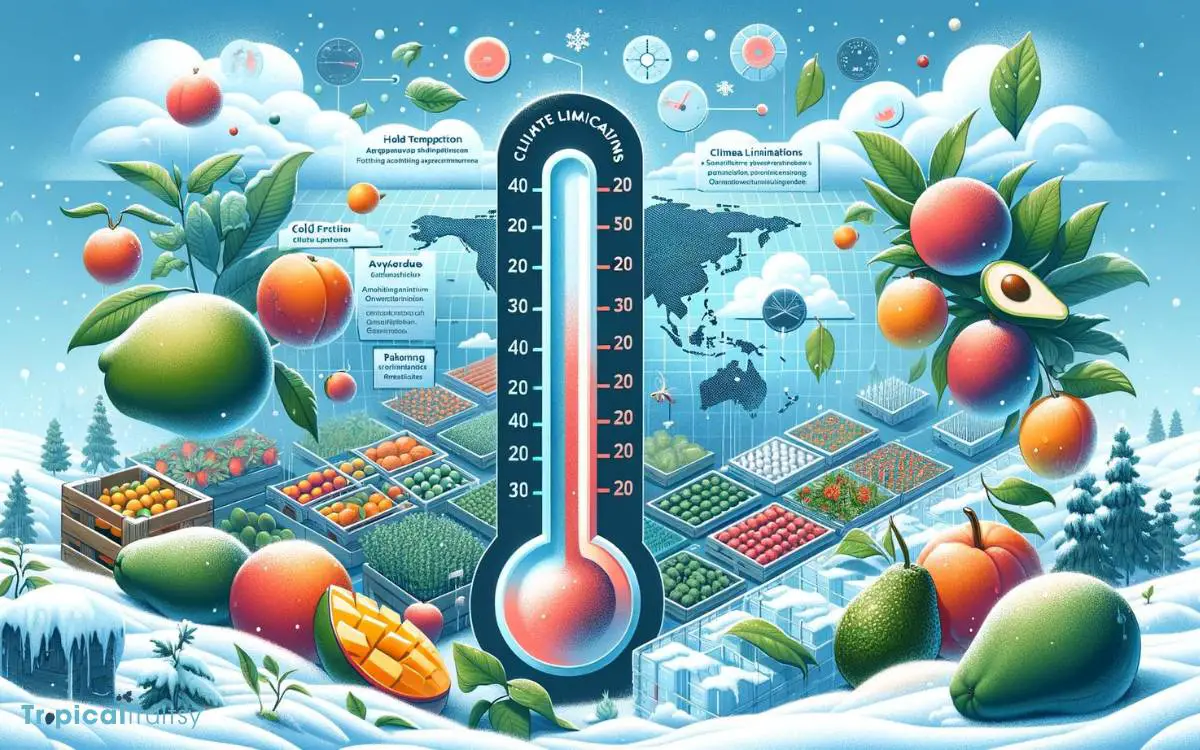
Before attempting to cultivate tropical fruit in a cold climate, it is essential to evaluate the specific climatic challenges, such as suboptimal temperature ranges and limited sunlight hours, that could significantly impact plant growth and fruit production.
To accurately assess these limitations, one must analyze historical climate data, including average temperatures, frost dates, and precipitation patterns.
This data provides a foundational understanding of the environmental constraints that must be mitigated.
Additionally, consideration of microclimate variations within the growing area is critical, as these can influence temperature and exposure to the elements.
An analytical approach to climatic assessment not only informs the selection of suitable tropical species but also dictates necessary adaptations in cultivation practices to enhance the chances of successful fruit yield in a cold climate.
Selecting Suitable Varieties
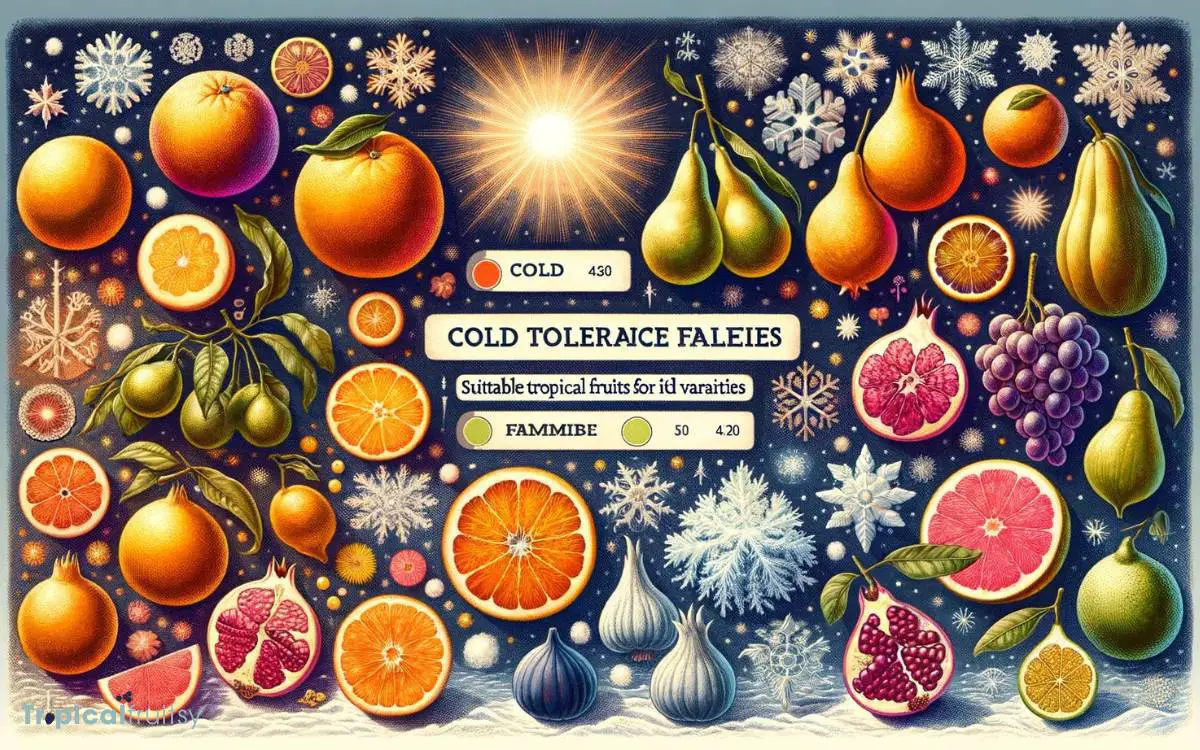
After assessing the climatic challenges, selecting a few hardy tropical fruit varieties that can tolerate cooler temperatures becomes the next crucial step in establishing a successful cold climate garden.
Cultivators must meticulously analyze the genetic traits and provenance of each species, seeking out those with inherent resilience to lower temperatures and shorter growing seasons.
A robust variety might include the ‘Feijoa’, known for its frost tolerance, or certain ‘Figs’ that can endure cooler climates.
Further consideration should be given to dwarf cultivars of ‘Avocados’ and ‘Papayas’, which may flourish indoors or within greenhouses where environmental control is feasible.
Each selection should be underpinned by empirical evidence of cold-weather viability to ensure the investment of time, resources, and effort yields a bountiful harvest.
Designing Protective Structures

In the pursuit of cultivating tropical fruits in colder climates, the design of protective structures plays a pivotal role in mitigating environmental stressors.
The selection of robust materials and advanced insulation techniques is critical to ensure thermal stability while minimizing energy consumption.
Moreover, integrating efficient ventilation systems is essential to maintain optimal humidity and temperature levels, thereby promoting plant health and fruit production.
Selecting Materials
Evaluate the durability and insulation properties of materials when designing protective structures for tropical fruit cultivation in cold climates.
The choice of construction materials is pivotal, directly impacting the efficacy and longevity of the microclimate you are attempting to establish.
Options such as polycarbonate panels offer robustness against harsh weather, coupled with excellent thermal retention characteristics.
For framework, galvanized steel provides a sturdy skeleton resistant to corrosion. Alternatively, treated timber can be employed for a more natural aesthetic; however, it requires vigilant maintenance against moisture and pests.
High-grade sealants and weatherproofing coatings should be considered essential to fortify joins and apertures against the elements.
Every material selected must contribute to an ensemble that harmonizes strength with superior insulation.
Transitioning to the intricacies of insulation techniques, one must delve into the specific methods that enhance the thermal efficiency of these meticulously chosen materials.
Insulation Techniques
During the construction of protective structures for tropical fruit cultivation in cold climates, employing advanced insulation techniques is critical to maintain a consistent and warm environment conducive to growth.
These strategies are designed to minimize heat loss and maximize energy efficiency, ensuring that tropical species thrive despite outside temperatures.
Consider the following insulation methods:
- Double-Layered Insulation: Implementing double walls with air or insulative materials in between reduces thermal exchange.
- Reflective Coatings: Applying reflective materials on internal surfaces to prevent heat from escaping.
- Subterranean Heat Storage: Utilizing the earth’s natural insulation by building partially or entirely below ground level.
- Automated Insulation Systems: Installing smart systems that adapt insulation levels based on real-time temperature data, optimizing energy use.
Each of these methods requires careful planning and implementation to create a stable microclimate for tropical fruit production.
Ventilation Systems
Proper ventilation systems are an essential component of any protective structure designed to cultivate tropical fruit in cooler climates.
These systems ensure that temperature and humidity remain within optimal ranges, thus preventing plant stress and promoting healthy growth.
Ventilation must be engineered to balance the internal environment, considering factors such as airflow patterns and external weather conditions.
| Factor | Consideration |
|---|---|
| Air Exchange Rate | Must ensure sufficient turnover to maintain air quality without causing excessive heat loss. |
| Humidity Control | Prevents condensation and mold growth, crucial for tropical species. |
| Temperature Regulation | Avoids overheating during sunny days and maintains warmth during cold nights. |
| Structural Integrity | Withstands external weather while allowing for adjustable ventilation openings. |
An analytical approach to designing these systems focuses on maximum efficiency with minimal energy input to achieve a sustainable operation.
As we delve deeper into the nuances of creating a conducive environment for tropical fruits, the next section will transition into the implementation of heating solutions, which work in tandem with ventilation to stabilize the internal climate.
Implementing Heating Solutions
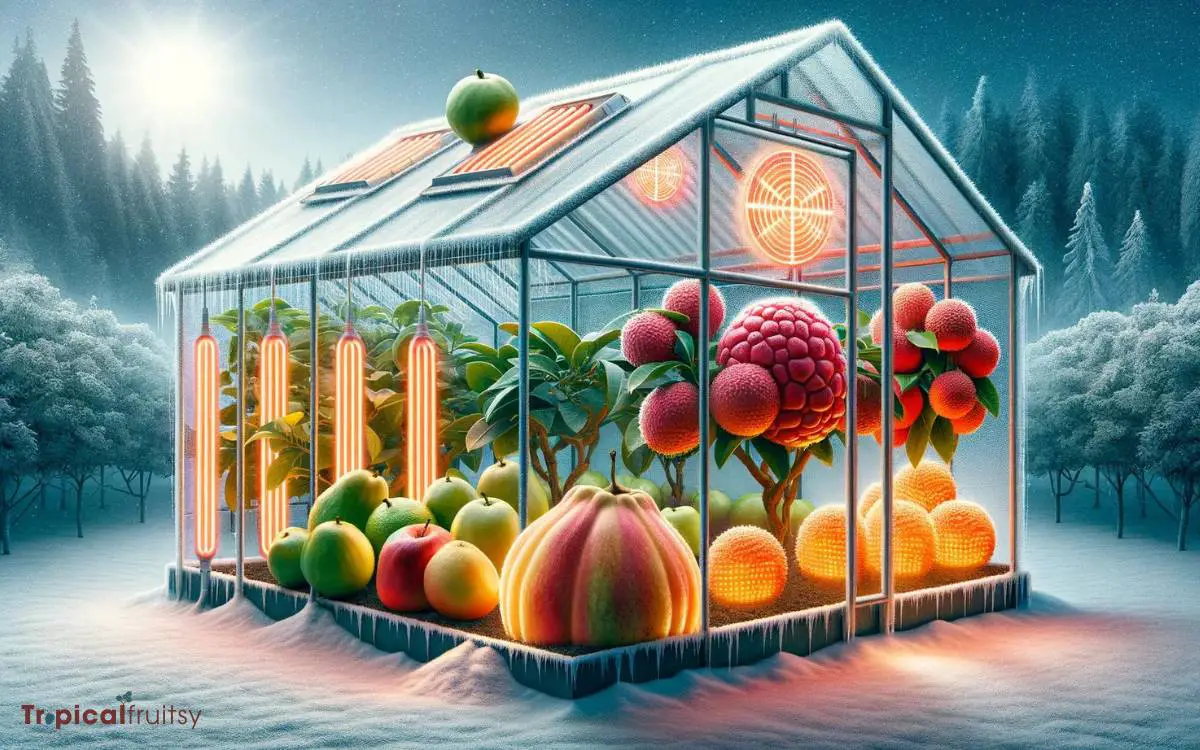
Greenhouse heating systems play a crucial role in maintaining a tropical microclimate necessary for cultivating tropical fruit in colder regions.
These systems must be carefully considered and implemented to ensure the delicate balance of warmth and humidity that tropical plants require.
Here are key considerations:
- Energy Source: Determine whether electric, gas, or renewable energy sources are most efficient and sustainable for your operation.
- Distribution Method: Analyze whether radiant heat, forced-air systems, or a combination thereof best serves your spatial and horticultural needs.
- Insulation: Ensure that your greenhouse is well-insulated to retain heat, minimizing energy waste and costs.
- Temperature Control: Install thermostats and sensors for precise temperature regulation, avoiding fluctuations that could stress the plants.
Having established a robust heating strategy, one must next turn their attention to managing soil and nutrition, which are equally pivotal in emulating a tropical fruit’s native habitat.
Managing Soil and Nutrition
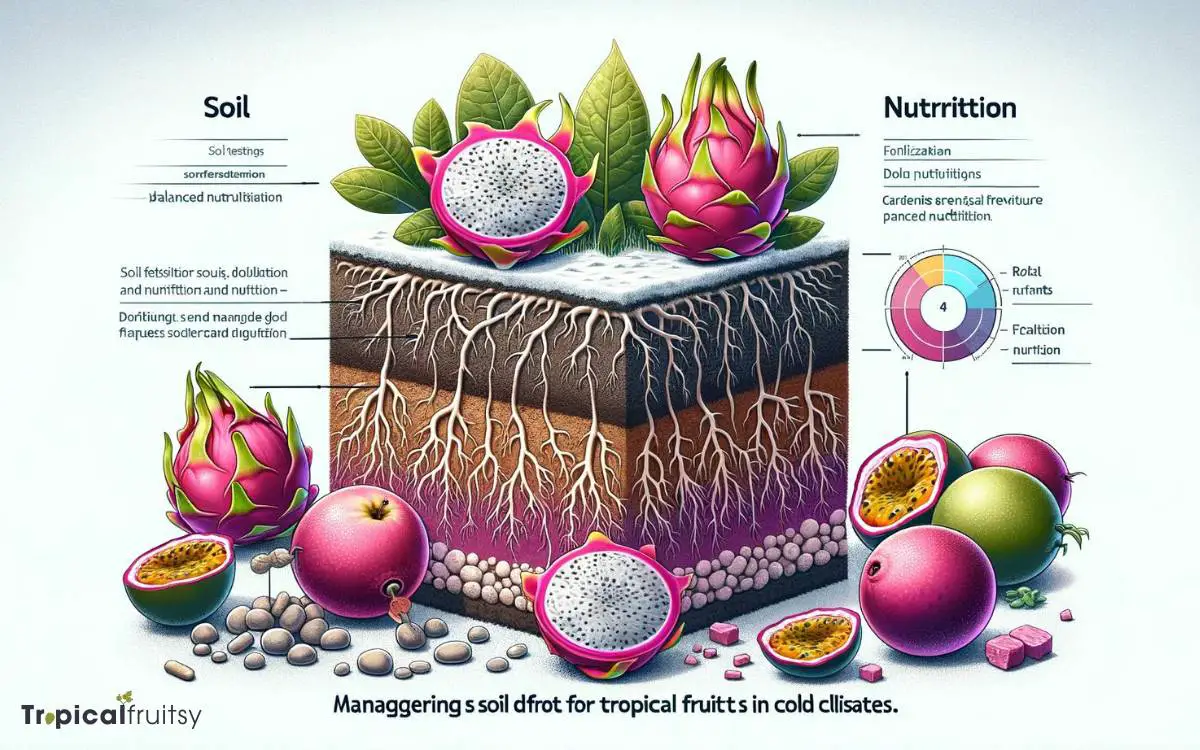
The successful cultivation of tropical fruits in non-native, colder climates hinges significantly on the precise management of soil conditions and plant nutrition.
Maintaining an optimal soil temperature is crucial for root development and metabolic processes, requiring innovative strategies for insulation and warming.
Furthermore, the integration of nutrient-rich compost is essential to ensure that the soil provides a full spectrum of essential minerals and organic matter, promoting robust plant growth and fruit production.
Soil Temperature Control
Maintaining an optimal soil temperature is crucial for the successful cultivation of tropical fruits in cold climates, as it ensures proper nutrient uptake and root development.
To achieve and sustain the necessary warmth in the root zone, consider these strategies:
- Utilize thermal mass, such as rock or water containers, to absorb and slowly release heat.
- Employ soil heating cables or mats specifically designed for horticultural purposes.
- Incorporate organic mulches to provide insulation against cold temperatures.
- Implement cold frames or greenhouse structures to shield the soil from extreme weather.
These methods require careful analysis and deployment to create a stable environment conducive to tropical fruit growth.
As we fine-tune the thermal conditions of the soil, we must also turn our attention to enhancing its fertility, particularly through the integration of nutrient-rich compost.
Nutrient Rich Compost
Incorporating nutrient-rich compost is essential for providing tropical fruit plants with the full spectrum of minerals and organic matter they require to thrive in a cold climate.
The composting process should be carefully managed to enhance the soil structure, which in turn improves root growth and water retention.
Analyzing the soil’s current nutrient profile is crucial before adding compost to ensure that the specific nutritional needs of the tropical plants are met.
An ideal compost for tropical fruit cultivation in colder regions would be rich in nitrogen, phosphorus, and potassium, as well as micro-nutrients like calcium and magnesium, which are vital for fruit development and disease resistance.
Regular monitoring and adjustments can sustain optimal soil fertility, propelling robust plant growth.
Transitioning now to the topic of acclimatizing and care practices, it becomes clear that while soil nutrition is foundational, the overall success also hinges on the precise management of the plant’s environment.
What are the best methods for growing tropical fruit in a cold climate?
Growing tropical fruit in a cold climate may seem challenging, but there are easy tropical fruit growing steps to help. Utilize greenhouse or indoor space, use heat lamps or grow lights, and consider dwarf varieties. Research the specific needs of each fruit and provide the proper care for successful cultivation.
Acclimatizing and Care Practices
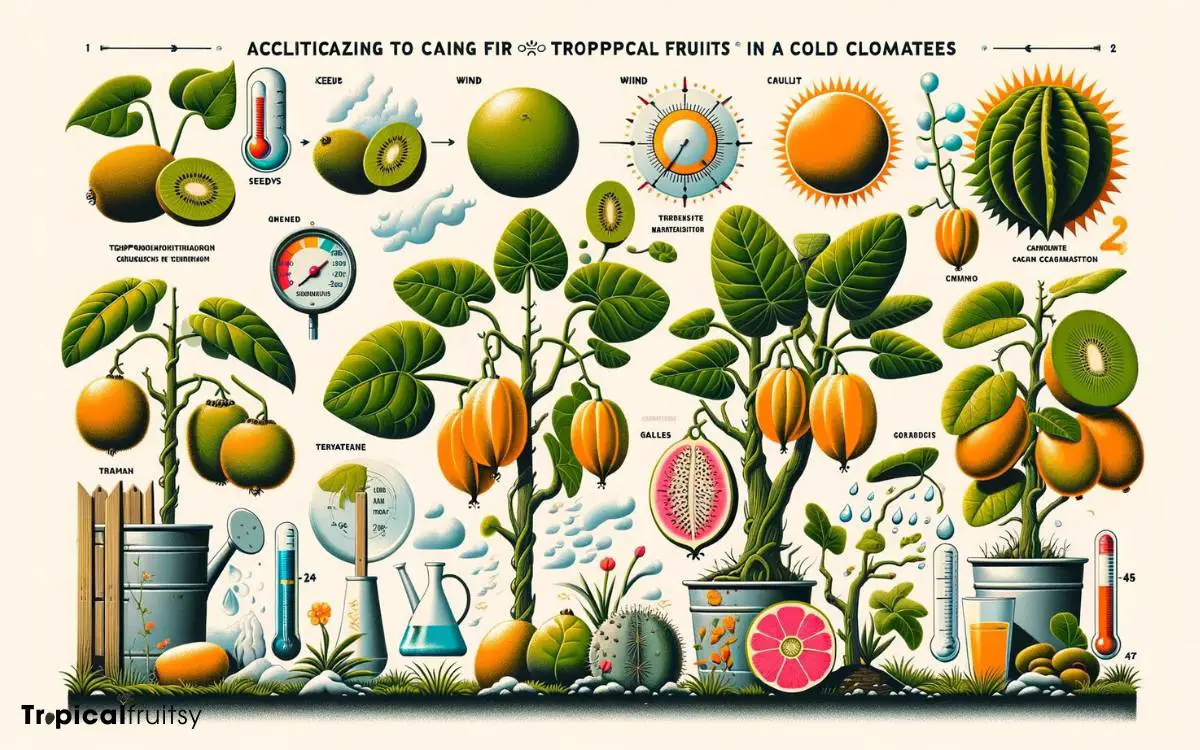
Climate adaptation strategies are essential for nurturing tropical fruit plants in regions with cooler temperatures.
The acclimatization process and subsequent care practices must be executed with precision if one hopes to achieve successful cultivation.
To engage in this process effectively, consider the following steps:
- Gradual Exposure: Begin by introducing your tropical plants to the colder climate gradually. Increase their exposure to lower temperatures over several weeks to avoid shock.
- Microclimate Creation: Utilize structures like greenhouses or cold frames to create a controlled environment that can be adjusted to mimic tropical conditions.
- Wind Protection: Erect barriers such as walls or hedges to shield plants from harsh winds that can exacerbate cold stress.
- Regular Monitoring: Keep a detailed log of temperature fluctuations, plant response, and growth patterns to fine-tune care practices and improve the microclimate conditions.
Conclusion
Cultivating tropical fruit in a cold climate epitomizes the triumph of horticultural ingenuity over environmental adversity.
Through meticulous climate assessment, judicious variety selection, construction of robust protective structures, strategic heating applications, precise soil and nutrition management, and diligent acclimatization and care, cultivators can create veritable oases that defy the frosty embrace of their local climes.
This endeavor, while Herculean, promises a bountiful harvest that belies the chill of its surroundings.

